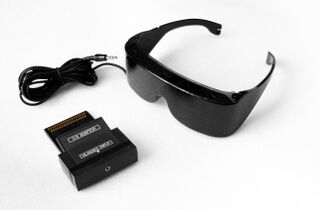Difference between revisions of "3-D Glasses"
From Sega Retro
Lukdriver14 (talk | contribs) m |
m (Text replacement - "{{fileref\|CVG UK 0([1-9][0-9]+)\.pdf\|page=(.*)}}" to "{{magref|cvg|$1|$2}}") |
||
| Line 14: | Line 14: | ||
| sms_rrp_jp=6,000{{ref|http://sega.jp/fb/segahard/master/3dglass.html}} | | sms_rrp_jp=6,000{{ref|http://sega.jp/fb/segahard/master/3dglass.html}} | ||
| sms_date_eu=1987 | | sms_date_eu=1987 | ||
| − | | sms_date_uk=1987-10{{ | + | | sms_date_uk=1987-10{{magref|cvg|73|132}} |
| sms_code_eu=MK-3073-50 | | sms_code_eu=MK-3073-50 | ||
| − | | sms_rrp_uk=39.95{{ | + | | sms_rrp_uk=39.95{{magref|cvg|77|10}}{{magref|cvg|90|105}} |
| sms_date_br=1989-09-04 | | sms_date_br=1989-09-04 | ||
| sms_rrp_br=500.00 | | sms_rrp_br=500.00 | ||
| Line 27: | Line 27: | ||
The 3-D Glasses use a shutter system to close the left and right lens rapidly to create a 3D effect. The Master System glasses can only be used in the original Master System, since it hooks up directly to the card port not found in the Master System II (US/EU model). Such a system allows 3-D graphics in full color. A disadvantage is that it halves the effective frame-rate, which some users can perceive as flicker. It also tends not to work with non-CRT-based televisions. | The 3-D Glasses use a shutter system to close the left and right lens rapidly to create a 3D effect. The Master System glasses can only be used in the original Master System, since it hooks up directly to the card port not found in the Master System II (US/EU model). Such a system allows 3-D graphics in full color. A disadvantage is that it halves the effective frame-rate, which some users can perceive as flicker. It also tends not to work with non-CRT-based televisions. | ||
| − | The Glasses were released in the UK in October 1987 at a price of £39.95,{{ | + | The Glasses were released in the UK in October 1987 at a price of £39.95,{{magref|cvg|77|10}} with the North American release in the same year. The 3-D Glasses were also released in Japan in November 1987 (initially bundled with [[Zaxxon 3D]]) and both Brazil and South Korea in 1989. |
==List of compatible games== | ==List of compatible games== | ||
Revision as of 07:47, 2 June 2019

| ||||||||||||||||||||||||||||||||||||||||
| 3-D Glasses | ||||||||||||||||||||||||||||||||||||||||
|---|---|---|---|---|---|---|---|---|---|---|---|---|---|---|---|---|---|---|---|---|---|---|---|---|---|---|---|---|---|---|---|---|---|---|---|---|---|---|---|---|
| Made for: Sega Master System | ||||||||||||||||||||||||||||||||||||||||
| Manufacturer: Sega | ||||||||||||||||||||||||||||||||||||||||
|
The 3-D Glasses (セガ3-Dグラス), also known as SegaScope 3-D Glasses, Óculos 3D in Brazil and Anteojos 3D in Argentina is a Sega Master System peripheral which creates the illusion of three-dimensional graphics in certain video games. They were invented by Mark Cerny of Marble Madness fame[5].
The 3-D Glasses use a shutter system to close the left and right lens rapidly to create a 3D effect. The Master System glasses can only be used in the original Master System, since it hooks up directly to the card port not found in the Master System II (US/EU model). Such a system allows 3-D graphics in full color. A disadvantage is that it halves the effective frame-rate, which some users can perceive as flicker. It also tends not to work with non-CRT-based televisions.
The Glasses were released in the UK in October 1987 at a price of £39.95,[3] with the North American release in the same year. The 3-D Glasses were also released in Japan in November 1987 (initially bundled with Zaxxon 3D) and both Brazil and South Korea in 1989.
Contents
List of compatible games
Magazine articles
- Main article: 3-D Glasses/Magazine articles.
Promotional material
US TV advert
Physical scans
| Master System, JP (Zaxxon 3D bundle) |
|---|
External links
References
- ↑ http://sega.jp/fb/segahard/master/3dglass.html
- ↑ Computer & Video Games, "November 1987" (UK; 1987-10-15), page 132
- ↑ Jump up to: 3.0 3.1 Computer & Video Games, "March 1988" (UK; 1988-02-15), page 10
- ↑ Computer & Video Games, "April 1989" (UK; 1989-03-16), page 105
- ↑ File:UltimateHistoryofVideoGames Book US.pdf, page 376
- ↑ Computer & Video Games, "May 1989" (UK; 1989-04-11), page 84
- ↑ ACE, "May 1989" (UK; 1989-04-06), page 68
- ↑ Computer & Video Games, "June 1989" (UK; 1989-05-16), page 89
- ↑ ACE, "June 1989" (UK; 1989-05-04), page 76
| CollapseSega Master System | |
|---|---|
| Topics | Sega Master System | Technical Specifications (Hardware Comparison) | History | Boot ROM | Magazine articles | Promotional material | Merchandise |
| Hardware | Asia | North America | Western Europe | Eastern Europe | South America | Australasia | Africa Sega Mark III | Sega Game Box 9 | Master System Girl | Master System Super Compact | Kiosk | Sega System E |
| Add-ons | Demo Unit II | Telecon Pack | FM Sound Unit | 3-D Glasses |
| Controllers | SJ-152 | Control Pad | 3-D Glasses | Control Stick | Handle Controller | Light Phaser | Paddle Control | Rapid Fire Unit | Sports Pad | SG Commander |
| Misc. Hardware | Action Replay | Card Catcher | Action Case | Freedom Connection | Playkit |
| Unreleased | Floppy Disk Drive |
| Consoles-on-a-chip | Arcade Gamer Portable | TF-DVD560 | DVD Karaoke Game DVT-G100 | Fun Play 20-in-1 | Handheld Electronic Games | Master System 3 Collection | Master System 3 | Master System Evolution | Master System Handy | PlayPal Plug & Play | Poga |














